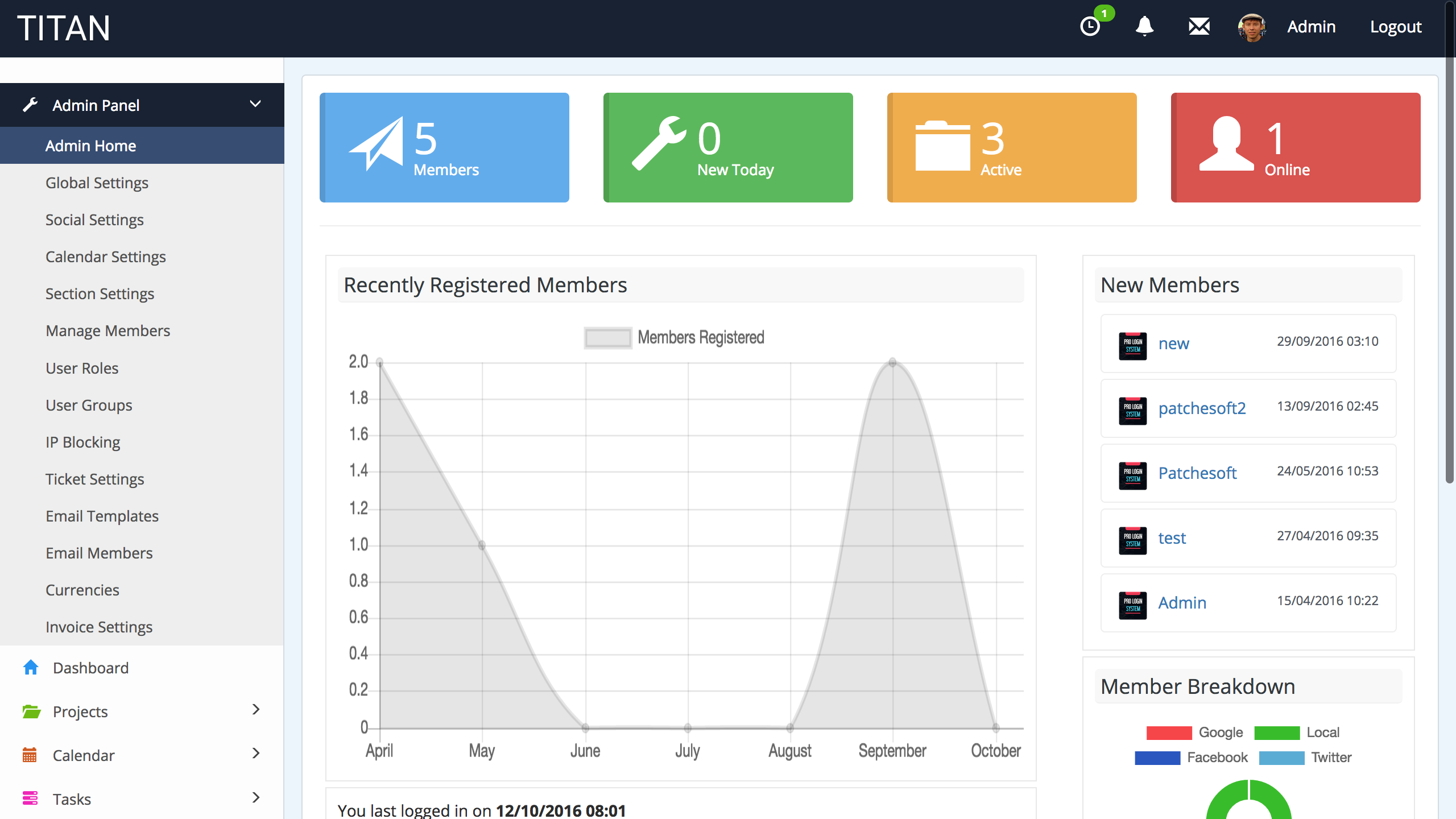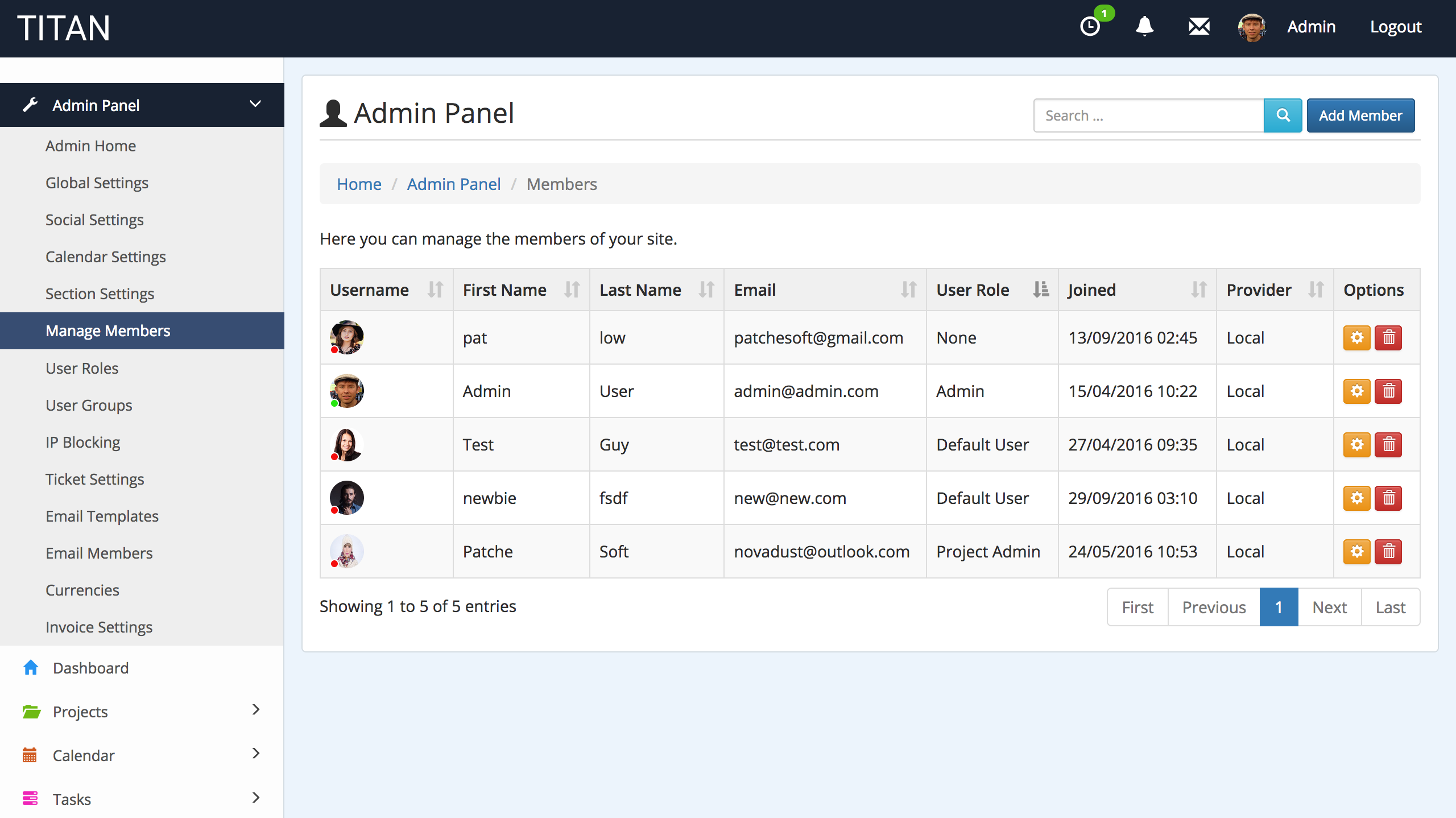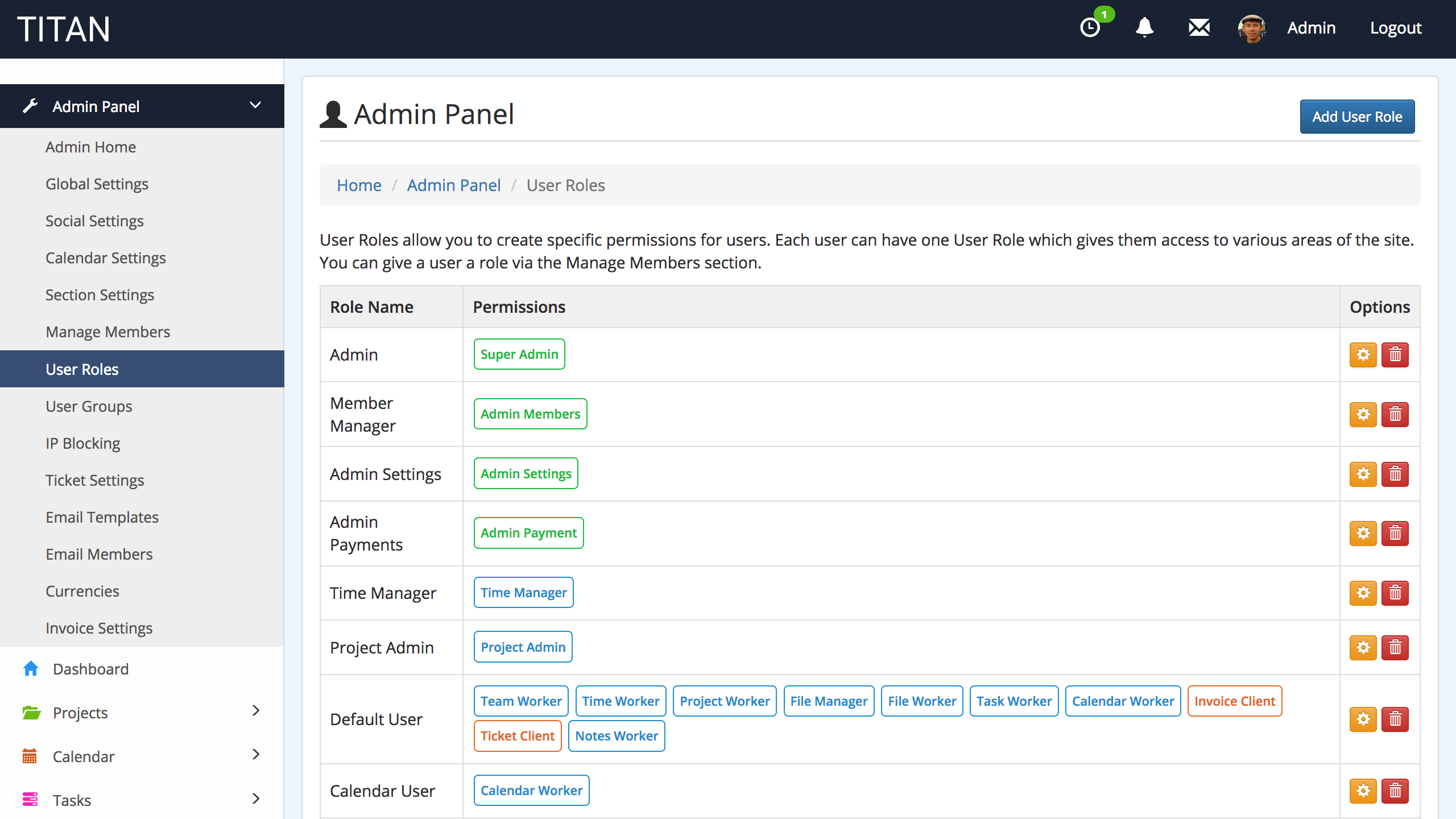Admin Panel
The Admin Panel is only available to users with the user role Super Admin, Admin Members, Admin Settings or Admin Payment. These user roles allow the user to specific areas of the Admin Panel, except for Super Admin which has access to everything.
The frontpage of the Admin Panel shows the recently registered members. It shows who registered, what service they registered with (if you have social media registration setup) and a graph of the last months count of registered users.

The Admin Panel has many sections that allow you to manage your TITAN application.
- Global Settings The global settings page allows you to change the logo, name and many other site-wide settings. It allows you to disable registration, enable brute force login protection, specify file types and file sizes and more.
- Social Settings The social settings is where you place your social media API keys. These settings allow users to create accounts on TITAN using their Facebook, Twitter and Google Accounts.
- Calendar Settings You can also change the way your Calendar works. There are two types of Calendars you can use: Site Calendar or Google Calendar. The site calendar uses the on site database to store events whereas the Google Calendar uses Google's Calendar API to connect to existing Calendars and load their data. Here you'll be able to specify the API keys to connect to Google Calendar.
- Section Settings The section settings allows you to turn off various areas of TITAN. You can enable/disable any of the main areas: Calendar, Tasks, Files, Teams, Notes, Invoices, Finance, Quotes and Timers.

The Admin panel also allows you to manage all your Members. You can edit/delete/add members. You can see all their information by clicking on Edit User. You can change their password, email address and also their User Role.

TITAN has a powerful User Role system. It allows you to completely control the permissions users have on your site. You can create custom roles with different permissions and assign them to individual users. This section describes all the User Roles and what permissions they give. You can view what each role does by hovering over the Role in the Admin Panel.
| Super Admin | Complete control over the site. Access all Admin Options and all pages. |
| Admin Settings | Access to Admin Panel Global Settings, Social Media Settings. |
| Admin Members | Access to Admin Panel Manage Members, User Groups, IP Blocking, Email Members. |
| Admin Payments | Access to Admin Panel Payment Plans, Payment Logs, Payment Settings. |
| Project Admin | Can do anything to any project, including create, edit, delete. Has access to all project sections. |
| Project Worker | Can create new projects. |
| Team Manager | Can view members of a project, edit, add and remove for every project. |
| Time Manager | Full access to the Time section. |
| Team Worker | Can view Team Section, but limited to only view team members in projects they are a part of. |
| Time Worker | Can view Time Section, but limited to only view timers in projects they are a part of. |
| File Worker | Can view the File Manager section, but only for projects you're a part of and have the team permission. |
| File Manager | Can view the File Manager section and view all files for all projects. |
| Task Worker | Can view the Task section, but only for projects you're a part of and have the team permission. |
| Task Manager | Can view the Task section and all tasks for all projects. |
| Calendar Manager | Can add/edit/delete Calendar Events for all projects. |
| Calendar Worker | Can view the Calendar section, but only for projects you're a part of and have the team permission. |
| Ticket Manager | Can add/edit/delete tickets, as well as add departments and custom fields. |
| Ticket Worker | Can add/edit/delete tickets. |
| Finance Manager | Can add/edit/delete finance entries for all projects and manage finance categories. |
| Finance Worker | Can add/edit/delete finance entries for projects they are involved in and have the finance project role. |
| Invoice Manager | Can add/edit/delete invoices for all projects. |
| Invoice Client | Can view invoices that have been assigned to them as the client. Cannot delete/create/edit invoices. |
| Ticket Client | Can view tickets they have created + create new tickets + reply. |
| Notes Manager | Can add/edit/delete/view all notes for all projects |
| Notes Worker | Can only view notes for Projects they are involved in and have the project team Notes role. Can only edit/delete their own notes. |
| Quote Manage | Can create/edit/delete new quotation forms + view any received quote requests. |
| Service Manage | Can create Service forms, view orders and more. |
| Project Client | Allows the user to view the progress of projects they have been added to. |
| Task Client | Allows the user to view a list of Tasks for the projects they have been added to. They also need the Project Team Role Client. |
You can mix permissions together. So you could have a User Role called Intern and give them the roles of Finance Worker, Invoice Client and Notes Worker.
- User Groups User Groups allow you to group users together. If you need to keep your members organised, you can assign them into groups.
- IP Blocking IP Blocking prevents users from logging in using a specific IP.
- Ticket Settings Ticket Settings allow you to setup Email Piping. This allows users to respond to tickets by using their Email Address rather than logging int othe ticket system.
- Email Templates Email Templates allow you change what emails are sent to users.
- Email Members This section allows you to send emails directly from your site to your registered users. You can also send out mass emails to User Groups.
- Currencies Currencies are just a list of currencies that can be used from Invoices.

Invoice Settings allow you to change the logo that is displayed on the Invoice and also the default address. The default address can be replaced by a User-specific address when the Invoice is created.
